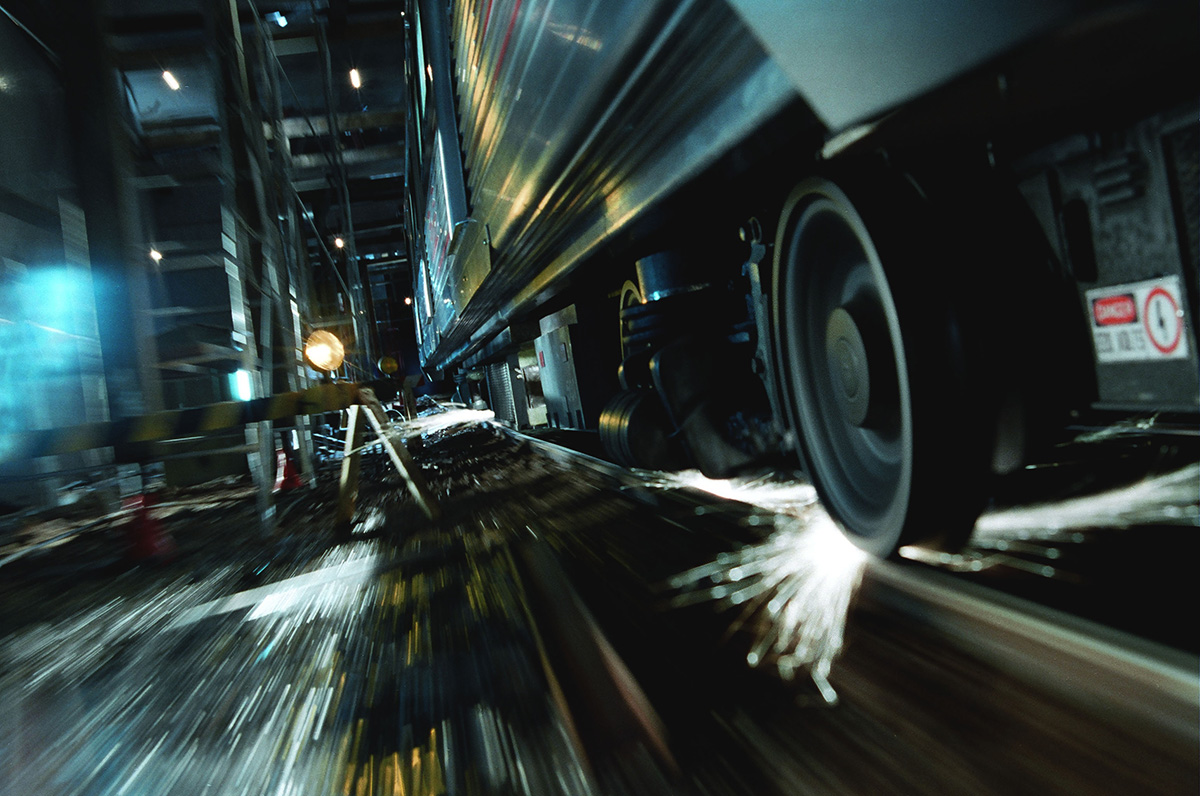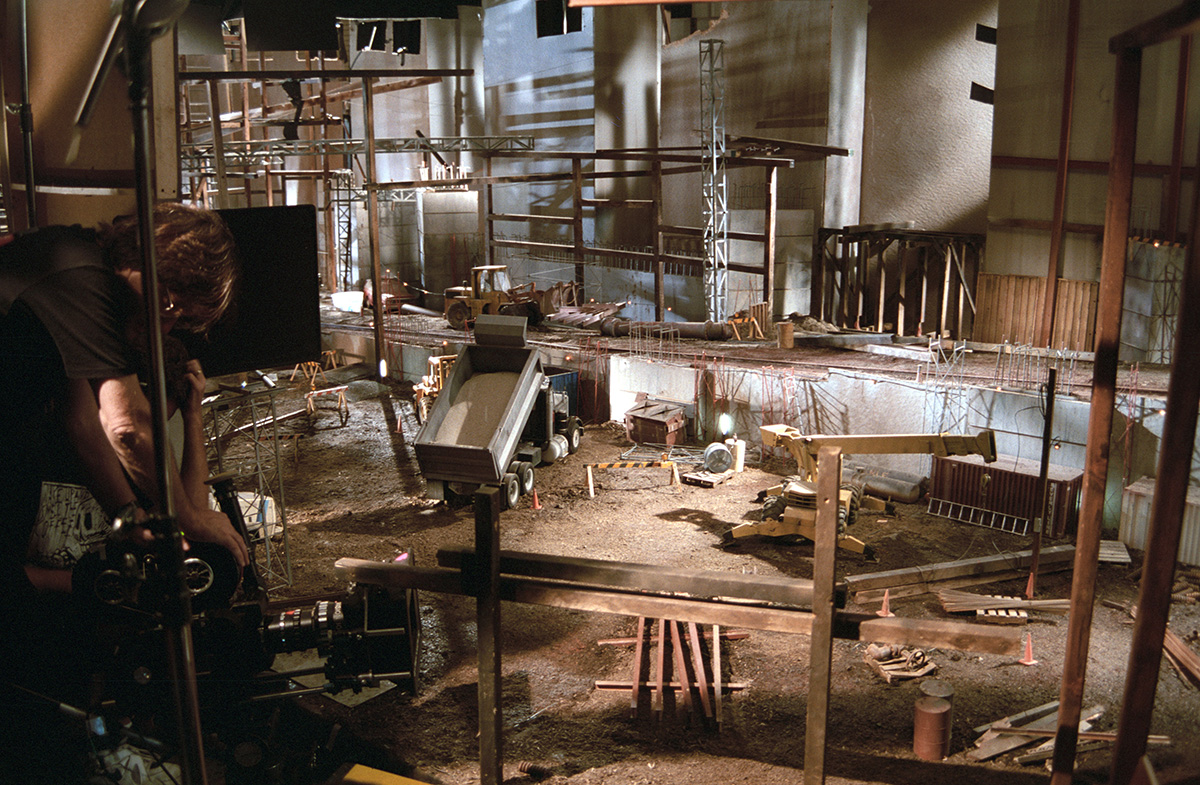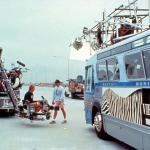Making models, crashing them, crafting sparks old-school, Front projection (!), simulating anamorphic lens flares, and the mistake that stayed in the film.

Just when Sandra Bullock and Keanu Reeves think they can get away from fast moving vehicles at the end of Jan de Bont’s Speed, they realize they’re stuck on a L.A. Metro train that can’t be slowed down or stopped. Luckily, however, the train can be sped up – don’t think too much on that – with Reeves’ character aiming to jump the tracks at a turn to avoid the train smashing into the end of the line.
What follows is a spectacular set of live-action and miniature effects for shots of the train rushing through a subway under construction and then eventually crashing out onto Hollywood Blvd. Back then (25 years ago!) this practical approach was very much part of an overall reliance on models and miniatures for scenes that could not be achieved at full scale.
Old-school techniques for generating sparks, pulling the trains with cables, and even using front projection, were part of the mix. And digital compositing – and even some optical compositing – was then used to combine multiple motion control miniature train passes together, and integrate certain elements. And sparks, lots of sparks. Read on, and enjoy the large visual history care of images from David Drzewiecki and Ron Brinkmann.

Shooting the crash for real, but in miniature
Speed’s miniature trains were built as 150 pound carriages by Jack Sessums’ Sessums Engineering. “Jack was the train specialist in the miniature world,” says Speed’s visual effects director of photography David Drzewiecki. “The trains were all very specialized things built at 1/8th scale – he had some things like wheel-bases or trucks from other projects but he would build them all in a ‘MacGyver-like’ way.”
In filming the crash scenes, Drzewiecki says he and Jan de Bont were keen to ensure that the camera and lighting placement matched what might have been able to be achieved in a full-scale environment. “If you were going to light a full-size train crash, you’d have an arsenal of lights and you have places where you can put cameras, in cherry pickers or down low on sandbags and you’d have lights that were a certain size, maybe 12K HMI. I don’t think the 18Ks even existed then.

“Or you had maybe the biggest bounce light – say 12 by 12 feet, so you divide that by eight, and it becomes a foot and a half. You wouldn’t put a 12 foot by 12 foot bounce over a miniature, per se, especially one that would be in an underground environment because that would be completely violating the scale of anything for real. So we adhered to that sort of philosophical approach, including all the lights – most of them were MR16 and some MR11s, they were these little tiny bulbs that were originally designed for track lighting or slide projectors. They put out a lot of light in a small space.”
“Then Jan would just choose where he wanted the cameras to be, and I’d ask him questions like, ‘If you were going to shoot this for real, how fast would you run a camera?’ ‘Well,’ he’d say, ‘I’d shoot this at 60 frames’ or ‘I’d shoot this at 72.’ We applied the rule of scale that translates to miniatures.”

“So if Jan was going to shoot this miniature event happening at 48 frames in real life, you would take that 48 frames and multiply it by a 2.5 frame rate multiplier derived by the square root of the inverse of the scale, scale being one-eighth, so it’s the square root of eight, so 2.5, roughly speaking. It came out to like 60-something, 64, something like that would be equivalent of 24 frames, and then to get to a 48 frame look it would be basically double that so you ended up running the cameras pretty much as fast you could run them to get a 48 frame look.”
It helped, of course, that de Bont had had vast experience already behind the camera as a cinematographer, notes Drzewiecki. “There are some camera angles that he chose that I thought weren’t going to work, because they were sort of in an odd place, maybe too high and, shit, they worked fine in the context of the edit! So Jan had a lot of experience that he brought to it as a cinematographer and as a director, knowing that he’d need certain cuts and angles and beats. He knew what he was going to be doing.”

Runaway train
As the train races through the subway – out of control – it speeds up so fast that construction workers need to run for their lives. A real train could not be filmed for such a dangerous stunt, so some of the shots were a mix of live-action plates and miniature trains composited together. The plates were of panicked subway construction workers running for cover from the out of control train.
The 1/8th scale trains by Sessums were rigged and wired for motion control, lined up and programmed to match the perspective and choreography of the backgrounds. Then, multi-pass photography was carried out for beauty lighting and headlights mattes. The reflective nature of the trains meant that front projection was used to generate suitable high-cons with minimal reflections convoluting the mattes. Interactive shadows and lights and even rippling water helped with integration.

Drzewiecki explains more: “So, firstly there were VistaVision plates that were shot when Los Angeles was building a subway system at that period. So we got real subway tunnels under construction. But then the trains were the miniatures and those were comp’d into those plates by Imageworks. We shot the miniatures with a little tiny Schmidt VistaVision camera – it was about the size of a Pringles container with a lens on one end of it and a magazine that could hold about 100 feet of film. The two rolls were in-line so the film would travel out, down inside the ‘Pringles’ film can, it would make a sharp turn, go through the aperture of the camera, and then come back past the other roll to the take-up spool.”
What this camera enabled the team to do was to get the lens – a Nikon lens – incredibly close to the miniature train. “So close,” says Drzewiecki, “that the train was rubbing against the edge of the lens. It was a process of lining up the background plate and the train. We had a clip of the film from the background plate that you’d register in the gate of the camera and you could view through that.”

“On the train itself,” adds Drzewiecki, “I think we had a little motion control actuator that pushed the train, heaved it up. If you see that when it makes a right turn, it sort of looks like it’s gonna topple over, that was done intentionally so there was this little actuator arm that we had programmed in there to push the train sort of up and over a little bit as it made that turn to look like it was top-heavy.”
In order to composite that shot, the filmmakers utilized a kind of front projection technique based on work by visual effects pioneer Jonathan Erland. “It might have been one of the last times that trick was ever used, actually,” suggests Drzewiecki. “It was sort of like his reverse front projection idea on how to get a matte. We provided some mattes but the train was shiny aluminium and the camera was at such an incident angle to the train that it just didn’t lend itself very well to, well, you couldn’t put a bluescreen back there, you couldn’t put a white screen, per se, because it would just reflect on the edge of the train, so we would go, ‘How are we gonna produce a matte?’”

“We just used this reverse front projection idea, and it was just a Scotchlite screen and a sheet of glass as a beam splitter behind the train and it just worked out really well that we were able to generate a matte pass that they could use in the comp. There’s two shots – the one where the train’s coming at you and the worker crosses over, and then that shot where the train makes a right turn.”
The whip-pan that wasn’t supposed to be
One of the goals in shooting the miniature train sequence was ensuring that, like the lighting, it matched the freneticism of the principal photography. This is seen in one particular shot where the camera focuses on the wheels of a train and then whip-pans with the train as it races away.

“That was done in only one take,” says Drzewiecki. “And it was actually done on motion control, believe it or not, and that whip-pan wasn’t supposed to be like that at all. That was an errant keyframe in the program and I think I even programmed that myself. Jan just wanted some cutaway shots of the wheels turning. So, we had to track the camera with the train, so we had a big long track, a straight motion control track, a straight train track, running in a straight line, and we had lights. There was an errant keyframe in the pan, and it was late in the evening and we thought, we’ll just develop it, because we saw it happen at the time but we finished the shot because the shot was going to be tracking along, and then you pan with the train as it recedes in the distance. That was the idea. But it didn’t quite work out that way.”
“We were going develop it and have it printed, look at the exposure, and then we’d re-shoot it first thing in the morning,” continues Drzewiecki. “I remember I was staying at a hotel that night, close by to where we were shooting, and I ended up getting out of there late and I had actually arrived at dailies after they looked at that shot and the producer said, ‘Jan loved that shot you did.’ And I said, ‘How is that even possible? That’s not possible. That was just a mistake. We were going shoot it over this morning.’ The camera was supposed to smoothly track with the train as it receded away and it held one position on the pan too long, so it was a mistake, but it worked out.”

The delicate art of lens flares and sparks
In the film, cinematographer Andrzej Bartkowiak shot with anamorphic lenses, and that provided many beautiful moments filled with trademark anamorphic lens flares. Looking to replicate that look – specifically horizontal blue lens flares that resembled flares from 1970s C series Panavision lenses – in the miniature train crash scenes, Drzewiecki and the filmmakers came up with a way to do it during the multi-pass shoot.
“The flares were generated by a piece of animation cell that had vertical lines scratched in it with a wire brush,” explains Drzewiecki, who adds that the scene to look out for to see the particular horizontal blue lens flares are where a subway train is heading towards camera and makes a turn. “We built a little holder that would hold it in front of the lens. We had a lens flare pass that we would use to generate these lens flares and then we had a blue filter and this homemade scratch filter. It was kind like the idea of a star filter; that’s how star filters work because they have intersecting etched lines. In this case, they were just one direction of scratching on a piece of animation cell.”

It’s worth noting, too, that some of the multiple passes of miniature train lights, brake lights and tail lights were composited optically (ie. with an optical printer) rather than digitally.
Also achieved largely in-camera and then composited into the shots (this time digitally) were particular spark elements emanating from the wheels of the train. “Jack Sessums made those,” states Drzewiecki. “To do that he used an electric motor that had a wheel on it. Along the perimeter of the wheel was like sandpaper and then he had a couple of flints like you’d find in a Zippo lighter that were held like a brush on an electric motor, held to the sandpaper. The motor would spin and it would shoot sparks out, kind of like a grinder. It was really just like a miniature grinder.”

An ingenious way to light inside trains
For one shot during the train carnage, the train that Sandra Bullock and Keanu Reeves is on jumps the tracks and its lights inside flicker for a second. This is seen in one fo the on-set shots of the characters, so it meant that the lights on inside the train had to be seen from outside (i.e. inside the miniature) for just a moment.
“Alan McFarland from Sessums came up with a way to do that,” says Drzewiecki. “This was before the days of LED lights, where they used ‘cold cathode fluorescents.’ If you had an older Apple computer or any older laptop, these didn’t have LED backlights, they were cold cathode backlights, like the size of a toothpick. And they used little tiny fluorescent bulbs, and a power supply. This put out a high-frequency, high-voltage output and they stuffed as many of them as they could aesthetically inside of the train.”

“Alan pushed the limits of their power-handling capacity, and that became our exposure. Those were the same bulbs that I think were used in the elevator shaft miniature. You would just use LEDs now that put out a shit-tonne of light. But back then we had to have like motorcycle batteries stuffed inside the train for the lights to make them go. It was a big process.”
A mangled mess
Although much of the train crash was achieved via motion control, some of the shots of trains jumping the tracks, plowing through the construction site, splitting in two and traveling up ramp towards the street above were filmed in a more ‘freewheeling’ way in miniature environments. Trains were rigged for speeds that reached 14 mph going into the crash.

“There were a series of cables that went under the track or along the track,” outlines Drzewiecki. “There was a cable that went along the edge of one of the tracks and then it went through a pulley and down, all the way to the end with another pulley, making a turn, and Jack had it attached to his 4-wheel quad, and he had marked out on the floor that on action he was gonna go from this stripe of tape in the floor to this stripe of tape in the floor as fast as he could. “That was the propulsion system used in Speed to crash a bunch of those trains – it was a cable pulled by an off-road quad.”
Explore our in-depth ‘Speed’ 25th anniversary coverage during #speedvfxweek.





























Great article. Nice to see the pictures of Jack Sessums, Dave et al. I did the miniature pyro for Money Train finale crash with much of this same team. Jack was indeed the king of the trains. We did a number of features together. (Back when miniature pyro supervisor was an actual job) Broken Arrow, American Outlaws, Down Periscope etc and some commercials. Always loads of fun. Dave Drzewiecki was also great to work with.
Seconding on how great this article reads, terrific mix of tech details and anecdotes. You’re also performing a public service unearthing pics I never remember seeing on these older films, Ian. Between you and New Zealand Pete’s matte site, I can get regular ‘fixes’ of analog magic.
Nice to see Mr. O’Connor weigh in here too — I remember talking with you about STAR TREK INSURRECTION for CINEFEX a long ways back, though I think we actually spent more time talking about the insanely awesome STARSHIP TROOPERS stuff!
Thanks Kevin!